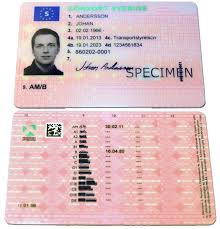12 Companies Leading The Way In New Driver's License Traffic Authority
페이지 정보
작성자 Gladis 작성일 25-02-03 08:02 조회 336 댓글 0본문
New Driver's License Authority and the Point System
New Yorkers who have had their license suspended may deal with a difficult road to getting it back. New guidelines that entered into impact in 2024 change the way DMV looks at your driving record when you are attempting to get a license back.
Drivers who are licensed in one state and receive a ticket in another typically assume that the offense won't impact them. Nevertheless, this is not constantly the case.
Point System
The Point System is an important tool that assists the New York State Department of Motor Vehicles identify high risk drivers and do something about it accordingly. By appointing point worths to specific traffic offenses, the system flags these violations instantly so that the DMV can investigate and possibly set into motion administrative fines, suspensions and more. Yonkers and White Plains traffic ticket legal representative Elisa Claro has counseled lots of drivers relating to the state's complex Point System and its effects.
As a basic guideline, any traffic offense that is categorized as moving violation will have points evaluated on one's driving record. Non-moving offenses, such as parking tickets, do not usually have actually any points related to them. A driver will have their license suspended if they get 12 or more points within 18 months.
A driver's insurance coverage rates might likewise increase if they get too lots of points. This is since insurance provider view drivers with excessive points on their records as being greater risk, which leads to them charging higher premiums for protection.
 Depending on the state, some systems may allow for a driver to have their points expunged after a particular time period. Others, nevertheless, will continue to have them on a person's record for longer.
Depending on the state, some systems may allow for a driver to have their points expunged after a particular time period. Others, nevertheless, will continue to have them on a person's record for longer.
Those who are dealing with a possible license suspension due to excessive points should understand the Driver Licensing Compact (DLC) contract between states. Under this contract, any DLC member state that convicts a driver of breaking its traffic laws will interact details of the conviction to the individual's licensing state, which may then take action as it would have done had actually the individual been convicted in that jurisdiction. This might consist of having the person's license suspended till they pay a fine, or in some cases, even permanently. The Alaska Department of Administration Division of Motor Vehicles describes its point system on its website. The Maine Driver Manual and Study Guide describes the state's point system, as does this PDF from The State of Oregon. The Maryland Driver Services page describes the state's point system. The Massachusetts Driver Handbook discusses the state's point system.
Administrative Action
A person can lose their license for körkortsfoto trafikverket malmö förnya körkort transportstyrelsen körkort (try this website) lots of reasons. Often, the suspension is the outcome of a court conviction, but there are also cases where the driver is detained for a traffic offense such as driving under the influence (DUI), and an administrative license suspension is purchased. These suspensions aren't the like a criminal conviction, since a person still can challenge the choice.
Lots of people do not recognize that if they get a ticket in one state, it can impact their home state's license too. This is due to the fact that a lot of states get involved in the Driver's License Compact, which means that they share info about drivers with each other. This consists of the information of any traffic ticket convictions and any administrative action that was taken against the driver.
Many of these kinds of administrative suspensions don't need a conviction in court, and they are often based on an arrest rather than a charge or proof. For example, a DUI arrest can activate an automatic suspension, if the driver is discovered to have a blood alcohol material above a particular level or declines to breathe test. These types of administrative suspensions might only last a short amount of time, however, and there's usually a method to contest the decision.
The driver must typically request a hearing before the DMV to object to a suspension. Throughout this hearing, the commissioner or other individual who chooses the case will evaluate the realities and proof. They will then choose whether the driver's privileges ought to be suspended, and if so, the length of the suspension. The driver has a restricted amount of time to request the hearing, and if they don't do so in a prompt way, the suspension will instantly enter into impact.
If the suspension is too long, a driver can submit an appeal to the DMV's Appeals Board. This appeal must be submitted within 60 days of the rejection letter. If the driver is able to show that the DMV has acted arbitrarily and capriciously, it will reassess the case. If the appeal is not successful, the driver can ask a federal court to evaluate it.
Boosted DRA
The boosted DRA is a charge that New York puts on drivers who break traffic laws. It costs drivers money, and it can trigger big problems if they don't pay it. It even affects out-of-state drivers who get points or commit particular major trafikverket göTeborg förnya Körkort traffic offenses in New York. Besides losing their right to drive in New York, these drivers might likewise lose their driving privileges in their home state.
To comprehend how the enhanced DRA works, consider it like an office complex that has essential locks on each door. Each worker requires to have a secret that opens their office, and maintenance workers should have access to all the doors. This would quickly result in an unmanageable variety of secrets in usage. Instead, the DRA acts as a 2nd protector of every file by protecting it with a file encryption that only the DRA certificate can open.
DRAs are deployed through the Group Policy Object Editor by creating a new data recovery representative account and deploying it utilizing a pre-generated DRA certificate or with a public/private key set that is created with Microsoft's built-in cipher tool. The DRA account should be an administrator account, and the DRA certificate need to be kept protected.
There are numerous ways to avoid an improved DRA, consisting of contesting a traffic ticket or working out a plea deal. Objecting to a traffic ticket might result in reduced or dismissed charges, which could prevent the points from amounting to six or getting an offense that qualifies you for a DRA. Additionally, a traffic legal representative can help you discover the finest way to avoid a DRA. For example, attending a defensive driving course may avoid you from getting a lot of points or striking the DRA limit.
Re-licensure
While the brand-new guidelines are developed to help keep harmful drivers off the road, some drivers say they're too lenient. For example, one rule reduces the bar for when a driver is considered a habitual violator from 5 to 4 convictions within a three-year period. The guideline likewise decreases the quantity of time a habitual violator needs to await his or her license to be renewed from 6 to three years.
Other changes are meant to simplify the re-licensure process for regular violators, allowing them to go back to driving faster than previously. Habitual violators will still have to satisfy rehab requirements and finish any required programs, but the re-licensure system now supplies a more well balanced path for reintegration into the certified driver neighborhood. This approach motivates adherence to traffic laws and lowers disruptions in daily life that can be triggered by a suspension or revocation.
The guidelines have also been designed to make sure that the licensing system stays up-to-date. The brand-new system will be connected to the National Driver Register and Commercial Driver License Information System, a clearinghouse that enables member states to exchange details about drivers and their convictions. This system will permit law enforcement officers to inspect a driver's record in other jurisdictions to guarantee that the individual is not a risk to highway safety and adhering to state laws.
In addition, the rules will make it easier for brand-new entrants to the system to get their licenses. The re-licensure process is now much easier and much faster, and the requirement for a brand-new license will be lowered to two years for Tier 3 and Tier 4 license holders.
Finally, the guidelines will enable New Yorkers, despite immigration status, to be provided a standard driver's license, permitting them to drive and run a registered, inspected, insured and insurable vehicle. This will supply more secure access to the transportation system and help immigrant families to maintain employment, which in turn helps the economy. Nevertheless, in typical governmental fashion, the new laws will not work till 2025. This is due to the fact that the TVB's software will not be upgraded up until then.
New Yorkers who have had their license suspended may deal with a difficult road to getting it back. New guidelines that entered into impact in 2024 change the way DMV looks at your driving record when you are attempting to get a license back.
Drivers who are licensed in one state and receive a ticket in another typically assume that the offense won't impact them. Nevertheless, this is not constantly the case.
Point System
The Point System is an important tool that assists the New York State Department of Motor Vehicles identify high risk drivers and do something about it accordingly. By appointing point worths to specific traffic offenses, the system flags these violations instantly so that the DMV can investigate and possibly set into motion administrative fines, suspensions and more. Yonkers and White Plains traffic ticket legal representative Elisa Claro has counseled lots of drivers relating to the state's complex Point System and its effects.
As a basic guideline, any traffic offense that is categorized as moving violation will have points evaluated on one's driving record. Non-moving offenses, such as parking tickets, do not usually have actually any points related to them. A driver will have their license suspended if they get 12 or more points within 18 months.
A driver's insurance coverage rates might likewise increase if they get too lots of points. This is since insurance provider view drivers with excessive points on their records as being greater risk, which leads to them charging higher premiums for protection.
 Depending on the state, some systems may allow for a driver to have their points expunged after a particular time period. Others, nevertheless, will continue to have them on a person's record for longer.
Depending on the state, some systems may allow for a driver to have their points expunged after a particular time period. Others, nevertheless, will continue to have them on a person's record for longer.Those who are dealing with a possible license suspension due to excessive points should understand the Driver Licensing Compact (DLC) contract between states. Under this contract, any DLC member state that convicts a driver of breaking its traffic laws will interact details of the conviction to the individual's licensing state, which may then take action as it would have done had actually the individual been convicted in that jurisdiction. This might consist of having the person's license suspended till they pay a fine, or in some cases, even permanently. The Alaska Department of Administration Division of Motor Vehicles describes its point system on its website. The Maine Driver Manual and Study Guide describes the state's point system, as does this PDF from The State of Oregon. The Maryland Driver Services page describes the state's point system. The Massachusetts Driver Handbook discusses the state's point system.
Administrative Action
A person can lose their license for körkortsfoto trafikverket malmö förnya körkort transportstyrelsen körkort (try this website) lots of reasons. Often, the suspension is the outcome of a court conviction, but there are also cases where the driver is detained for a traffic offense such as driving under the influence (DUI), and an administrative license suspension is purchased. These suspensions aren't the like a criminal conviction, since a person still can challenge the choice.
Lots of people do not recognize that if they get a ticket in one state, it can impact their home state's license too. This is due to the fact that a lot of states get involved in the Driver's License Compact, which means that they share info about drivers with each other. This consists of the information of any traffic ticket convictions and any administrative action that was taken against the driver.
Many of these kinds of administrative suspensions don't need a conviction in court, and they are often based on an arrest rather than a charge or proof. For example, a DUI arrest can activate an automatic suspension, if the driver is discovered to have a blood alcohol material above a particular level or declines to breathe test. These types of administrative suspensions might only last a short amount of time, however, and there's usually a method to contest the decision.
The driver must typically request a hearing before the DMV to object to a suspension. Throughout this hearing, the commissioner or other individual who chooses the case will evaluate the realities and proof. They will then choose whether the driver's privileges ought to be suspended, and if so, the length of the suspension. The driver has a restricted amount of time to request the hearing, and if they don't do so in a prompt way, the suspension will instantly enter into impact.
If the suspension is too long, a driver can submit an appeal to the DMV's Appeals Board. This appeal must be submitted within 60 days of the rejection letter. If the driver is able to show that the DMV has acted arbitrarily and capriciously, it will reassess the case. If the appeal is not successful, the driver can ask a federal court to evaluate it.
Boosted DRA
The boosted DRA is a charge that New York puts on drivers who break traffic laws. It costs drivers money, and it can trigger big problems if they don't pay it. It even affects out-of-state drivers who get points or commit particular major trafikverket göTeborg förnya Körkort traffic offenses in New York. Besides losing their right to drive in New York, these drivers might likewise lose their driving privileges in their home state.
To comprehend how the enhanced DRA works, consider it like an office complex that has essential locks on each door. Each worker requires to have a secret that opens their office, and maintenance workers should have access to all the doors. This would quickly result in an unmanageable variety of secrets in usage. Instead, the DRA acts as a 2nd protector of every file by protecting it with a file encryption that only the DRA certificate can open.
DRAs are deployed through the Group Policy Object Editor by creating a new data recovery representative account and deploying it utilizing a pre-generated DRA certificate or with a public/private key set that is created with Microsoft's built-in cipher tool. The DRA account should be an administrator account, and the DRA certificate need to be kept protected.
There are numerous ways to avoid an improved DRA, consisting of contesting a traffic ticket or working out a plea deal. Objecting to a traffic ticket might result in reduced or dismissed charges, which could prevent the points from amounting to six or getting an offense that qualifies you for a DRA. Additionally, a traffic legal representative can help you discover the finest way to avoid a DRA. For example, attending a defensive driving course may avoid you from getting a lot of points or striking the DRA limit.
Re-licensure
While the brand-new guidelines are developed to help keep harmful drivers off the road, some drivers say they're too lenient. For example, one rule reduces the bar for when a driver is considered a habitual violator from 5 to 4 convictions within a three-year period. The guideline likewise decreases the quantity of time a habitual violator needs to await his or her license to be renewed from 6 to three years.
Other changes are meant to simplify the re-licensure process for regular violators, allowing them to go back to driving faster than previously. Habitual violators will still have to satisfy rehab requirements and finish any required programs, but the re-licensure system now supplies a more well balanced path for reintegration into the certified driver neighborhood. This approach motivates adherence to traffic laws and lowers disruptions in daily life that can be triggered by a suspension or revocation.
The guidelines have also been designed to make sure that the licensing system stays up-to-date. The brand-new system will be connected to the National Driver Register and Commercial Driver License Information System, a clearinghouse that enables member states to exchange details about drivers and their convictions. This system will permit law enforcement officers to inspect a driver's record in other jurisdictions to guarantee that the individual is not a risk to highway safety and adhering to state laws.
In addition, the rules will make it easier for brand-new entrants to the system to get their licenses. The re-licensure process is now much easier and much faster, and the requirement for a brand-new license will be lowered to two years for Tier 3 and Tier 4 license holders.
Finally, the guidelines will enable New Yorkers, despite immigration status, to be provided a standard driver's license, permitting them to drive and run a registered, inspected, insured and insurable vehicle. This will supply more secure access to the transportation system and help immigrant families to maintain employment, which in turn helps the economy. Nevertheless, in typical governmental fashion, the new laws will not work till 2025. This is due to the fact that the TVB's software will not be upgraded up until then.









